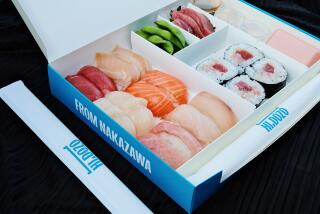After Decline, New Stores Attracting Business : Glittering Tokyo Ginza Enjoying Revival
- Share via
TOKYO — After a period of decline, the Ginza, Tokyo’s garish yet fashionable fantasyland for more than a century, is drawing back patrons who had defected to trendier places.
New department stores are going up among the Ginza’s 3,400 bars and restaurants and its 500 smaller retail stores.
The government recently announced a $1.4-billion plan to relocate the Ginza’s subway stations, build a four-level underground shopping center and construct hotels and apartments above nearby expressways.
The “revival of the Ginza” has become a media catch phrase as thousands of shoppers and diners flock back to the place where Western ways made their debut in Japan in the 1870s.
The Ginza--the name means “silver seat”--was a popular and fashionable district for the better part of a century, until rival commercial districts sprang up in Tokyo’s postwar expansion.
But with the addition of three new shopping emporiums last year--the first in 27 years--the Ginza now has eight major department stores in its 163 acres of space.
The first of the new shopping magnets was Printemps, a French specialty store that opened last April in a joint venture with a Japanese supermarket chain.
In October, the Hankyu and Seibu stores opened in a 14-story twin building called Mullion--after the decorative pillars that divide its windows--on the former sites of the national newspaper Asahi and the Nichigeki Theater, once famed for burlesque and nude shows.
Five movie theaters, numerous restaurants and a bank in the massive complex also help attract an estimated 300,000 visitors a day, and all this has helped the established businesses in the Ginza.
Yuji Ishimaru, spokesman for the Ginza Street Assn., a business group, estimated that last year’s sales by major stores, which came to about $600 million in 1983, will exceed $800 million when totaled up.
But there are more than shopping palaces in the Ginza.
At twilight, there remain the hand-pulled jinrikisha and the traditional geishas who entertain the rich and famous. There’s the Kabukiza, home of Japan’s traditional theater, with its braid of red lanterns and upswept eaves.
There are hole-in-the-wall bars where kimono-clad women coddle expense-account executives with whiskey at $100 a drink. There are sidewalk fortune tellers, bonsai tree sellers, noodle vendors and shops selling fabulously expensive kimono accessories.
The Ginza area, now one of the world’s most expensive pieces of real estate, was under seawater until the 17th Century, when the shogun Tokugawa Ieyasu launched an ambitious landfill project in his new capital, then called Edo. The shogunate’s silver-minting center was there, which is why the area became known as the Ginza.
In 1872, about 20 years after Japan ended more than two centuries of feudal isolation, a fire ravaged the area, and that gave Emperor Meiji a chance to make the Ginza a symbol of Japan’s new policy of looking westward.
A British architect was hired to design sturdy, two-story brick buildings, with European-style terraces, along Ginza Street--then lined with cherry and maple trees and Japan’s first curbed sidewalk.
Other disasters followed. From the ruins of the Great Kanto Earthquake of 1923 came Matsuzakaya and Matsuya, the Ginza’s first department stores. That era also gave the language the words mobo and moga-- “modern boy” and “modern girl”--a new breed of sophisticates who passed weekends in “Ginza-bura”--strolling through the Ginza.
Since the area’s recent revival, said Takashi Nakamura, a professor at the Tokyo College of Economics who has studied the Ginza, “Ginza-strolling” has increased more than 20%.
The Ginza also became Tokyo’s newspaper row, with about 30 newspapers based there, and the nation’s art center. Today it still has about 200 art galleries.
Kiharu Nakamura, a geisha in the Ginza before and after World War II, recalled that in prewar days there were 1,500 geishas--skilled entertainers and performers of traditional music and dance--in the area.
“They were the nation’s fashion leaders in hairdos and kimono,” she said.
The bars were then “very few, very European and very quiet,” but the streets were alive with music from dance halls and the cries of peddlers.
The expressway that now marks the east side of the Ginza was then a canal, one of several drained after World War II.
“We used to have boat parties down that beautiful river under the full moon in summer,” said Nakamura, 71, who now lives in New York.
More to Read
Inside the business of entertainment
The Wide Shot brings you news, analysis and insights on everything from streaming wars to production — and what it all means for the future.
You may occasionally receive promotional content from the Los Angeles Times.










